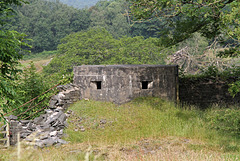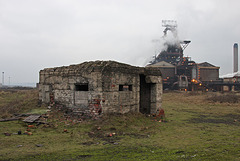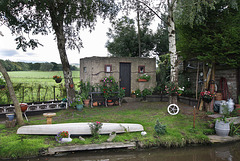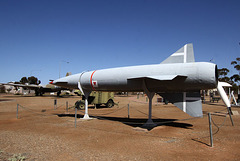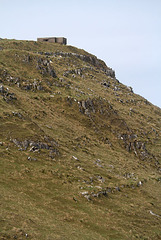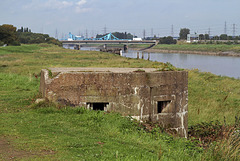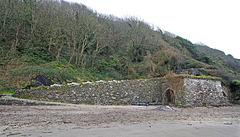
Military
Haverthwaite Pillbox
Pillbox at Redcar furnace
| |
|
Defending the coast and the steelworks. Pillbox on the dunes/slag outside the Redcar steelworks. The brick facing was, I believe, initially used as a form of shuttering for pouring the concrete. It was then left in situ as extra protection.
The Gare
| |
|
Defence of the entrance to the Tees and the Redcar furnaces included a series of pillboxes on the coast. Erosion of the dunes under this example at The Gare has seen it toppled. The background is formed by the steelworks and associated coking plant.
Defending Roften
| |
|
At the former Ordnance Factory No.10 (Roften) at Hooton, stood this pillbox, still guarding the perimeter from attack. The factory manufactured heavy anti-aircraft guns during WWII.
Pillbox - but not as we know it
| |
|
Type 24 pillbox alongside Bridge 13 at Middlecale on the Macclesfield Canal. This was one of the defensive structures along Stop Line No.6 which ran, mainly along canals from Tamworth to south-east Manchester. These days it performs peaceful duties as a garden shed/store for the adjacent moorings.
Porthleven
| |
|
It was a breezy day when I visted Porthleven and the sea was rolling in with big breakers. The entrance to the harbour is guarded by this pillbox, just in case of an attempted invasion.
Defence of the realm
| |
|
In the dark days of 1940/41 there was a real fear of invasion after the German forces overran the nearby European countries, and desperate efforts were made to develop defences within Britain to help stop or at least slow down an invading force. One method was the use of roadblocks incorporating concrete cylinders that were supposed to be able to obstruct mechanised traffic. The remains in this image are part of a factory that was set up to manufacture these cylinders and was abandoned after the invasion scares were over. Since then it has lain derelict and quietly disappearing into the woodland that has developed on teh site. The pulley wheel is attached to one of three pan mills used for preparing materials and the corrugated iron sheets are what little is left of the building that once protected the machinery. There is also a batch concrete mixer and dozens of unused cylinders around the area.
Nakhoda Ragam class
| |
|
|
The Nakhoda Ragam class is a class of corvette offshore patrol vessels originally built for the Royal Brunei Navy and named after the lead ship of the class, in turn named after a legendary Malay seafarer. Three vessels were built by BAE Systems Marine (now BAE Systems Maritime - Naval Ships). The ships were to be named:
KDB Nakhoda Ragam
KDB Bendhara Sakam
KDB Jerambak
The customer refused to accept the vessels and the contract dispute became the subject of arbitration. When the dispute was settled in favour of BAE Systems, the vessels were handed over to Royal Brunei Technical Services in June 2007. In 2013 it was announced that these warships had been sold to the Indonesian Navy and would soon be leaving Barrow where they have been laid up since 2007.
"Consol" shelter
| |
|
|
|
Advert for fire watching shelter. There are still odd ones lying around as the steel they were made of was so thick.
Marching in
| |
|
|
Prisoners of War arriving at Cultybraggan Camp 21 after marching from the station under escort. Re-enactment from the excellent camp open day.
The prisoner of war camp at Cultybraggan was completed in late 1941 and originally used to house Italian prisoners. It was later used as a transit camp for Germans and as a high security establishment for holding ardent nazis. Later it became a MOD training centre until closure in 2004. It is now owned by the local community through the Comrie Development Trust. The camp still contains a large number of nissen huts and these make a spectacular sight.
Cark airfield
| |
|
|
Watch office at RAF Cark with a smaller Fighter Satellite Watch Office to the right. The airfield was constructed for fighters in late 1940 but appears to have been mainly used for anti-aircraft training and later for pilot training.
High Edge pillbox
| |
|
|
This type 23 pillbox was built way up on High Edge to protect the extensive bomb storage area at RAF Harpur Hill. The access was over the wall at the back of the structure (right side of this view) where there was a mount for a light anti-aircraft weapon.
Pipeline pumping station
| |
|
|
I spotted this whilst driving past and returned for a closer look. It appears to be a fuel pipeline pumping station dating back to WW2. The surviving building is very similar to that at Poynton (see below) although in this case the rainheads are rather fancy.
Blue Steel
| |
|
|
On display at Woomerra is this AVRO Blue Steel missile which was developed as Britain's strategic air launched nuclear warhead delivery system in the 1950s although it did not go into service until 1963. Carried by Vulcan and Victor bombers the missile was reputedly very unreliable and also had a very short range. Its role was replaced by submarine launched Polaris missiles from 1968.
Bromborough Bridge pillboxes
| |
|
|
One of two pillboxes guarding the ends of the bridge over Bromborough Pool next to the Port Sunlight works.
Defensive position
| |
|
|
|
This type 23 pillbox was built way up on High Edge to protect the extensive bomb storage area at RAF Harpur Hill.
Defending the Dee
Polkerris
| |
|
The limekiln at the top of the beach at Polkerris was erected in 1827 by local farmers John Andrew and George Boscestow. It was long disused by the Second World War when a pillbox was constructed on top.
Jump to top
RSS feed- Latest items - Subscribe to the latest items added to this album
- ipernity © 2007-2024
- Help & Contact
|
Club news
|
About ipernity
|
History |
ipernity Club & Prices |
Guide of good conduct
Donate | Group guidelines | Privacy policy | Terms of use | Statutes | In memoria -
Facebook
Twitter

